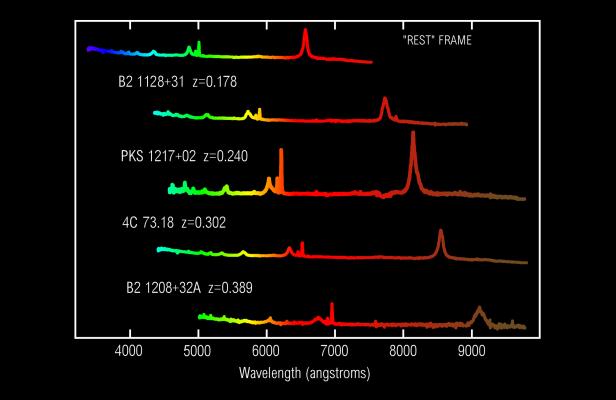<<PREVIOUS -
HOME -
CONTENTS -
NEXT>> -
![]()
<<PREVIOUS -
HOME -
CONTENTS -
NEXT>> -
![]()
Quasi-Stellar Objects (QSO) is class of objects beyond our Milky Way Galaxy that have a starlike visual appearance except that the optical spectrum has a large redshift. Quasars (quasi-stellar radio sources) are strong radio sources that are starlike. A QSO may have a strong radio source or may not have a strong radio source.
A QSO optical appearance in an image looks like other dim stars except the QSO optical spectrum is different than a dim star.
Links: Wikipedia Quasar, List of quasars and Active galactic nucleus

This image shows the spectra of four quasi-stellar objects (QSOs), along with an example of what the spectrum might look like for a typical QSO if it were not moving away from us. The upper spectrum, designated "Rest" Frame, shows the spectrum of a QSO moving at zero velocity with respect to the Earth. Four additional QSO spectra with increasing "redshift", or recession velocity, are shown as they appear to observers on Earth. The spectral lines are shifted more and more toward the red as the redshift increases
Above Text and Image credit for this section: C. Pilachowski, M. Corbin /NOAO/AURA/NSF, National Optical Astronomy Observatory/Association of Universities for Research in Astronomy/National Science Foundation (NOAO/AURA/NSF)
Links
Time Scale
|
Time |
Event |
Redshift (z) |
|
8 min. & 19 sec. |
Light travel-time from the Sun |
|
|
8.6 yr |
Light travel-time from the star Sirius |
|
|
195,000 yr |
||
|
Light travel-time from Messier M31 galaxy |
||
|
1.572 Gyr |
Light travel-time from QSO LBQS 0042-2550 near NGC253 |
0.128054 |
|
4.5 Gyr |
||
|
4.544 Gyr |
Light travel-time from QSO LBQS 0042-2550 near NGC253 |
0.453046 |
|
4.776 Gyr |
Light travel-time from QSO [HB89] 0045-260 near NGC253 |
0.485056 |
|
6.536 Gyr |
Light travel-time from QSO [WHO91] 0048-259 near NGC253 |
0.779059 |
|
8.176 Gyr |
Light travel-time from QSO LBQS 0047-2522 near NGC253 |
1.183052 |
|
8.360 Gyr |
Light travel-time from QSO LBQS 0045-2606 near NGC253 |
1.241056 |
|
9.104 Gyr |
Light travel-time from QSO [HB89] 0046-251 near NGC253 |
1.516046 |
|
9.545 Gyr |
Light travel-time from QSO [WHO91] 0041-262 near NGC253 |
1.719048 |
|
9.545 Gyr |
Light travel-time from QSO [WHB96] 0041-2608 near NGC253 |
1.719048 |
|
9.991 Gyr |
Light travel-time from QSO LBQS 0047-2538 near NGC253 |
1.968055 |
|
10.166 Gyr |
Light travel-time from QSO LBQS 0048-2545 near NGC253 |
2.081058 |
|
10.207 Gyr |
Light travel-time from QSO [VCV96] Q 0048-2526 near NGC253 |
2.109054 |
|
10.398 Gyr |
Light travel-time from QSO [HB89] 0048-261 near NGC253 |
2.248062 |
|
10.699 Gyr |
Light travel-time from QSO [CT83] 034 near NGC253 |
2.500048 |
|
10.721 Gyr |
Light travel-time from QSO [HB89] 0045-258 near NGC253 |
2.520053 |
|
11.386 Gyr |
Light travel-time from QSO [WHO91] 0043-259 near NGC253 |
3.309050 |
|
11.831 Gyr |
Light travel-time from QSO BRI J0048-2442 near NGC253 |
4.149044 |
|
~13 Gyr |
Light travel-time from the most distant known quasar | |
|
12 to 14 Gyr |
David Haworth QSO Images